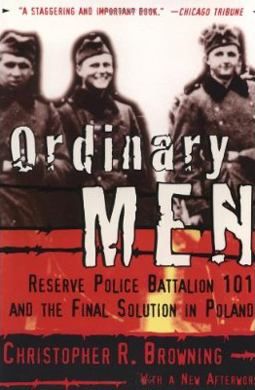Browning, Christopher. Ordinary Men: Reserve Police Battalion 101 and the Final Solution in Poland. New York: Harper Perennial, 1998.
With this book, Christopher Browning has written a remarkable and chilling chapter of Holocaust history. In this microhistory, he seeks to understand how ordinary men from Hamburg, most of whom were not even ardent Nazi Party supporters, became mass murderers within months of being shipped to Poland. Browning uses interviews and archival material to recreate, in vivid and bloody detail, daily life for these five hundred men, and ends his book by trying to tease out the psychological reasons that many of these men became increasingly efficient killers.
Browning uses footage from about 250 interviews that were performed as interrogations during the 1960s. In these interrogations, Reserve Police Battalion 101 members provided detailed accounts of what happened during the two years following their arrival in German-occupied Poland in June 1942. Browning is forthright about his research methods, highlighting the troubles of relying on oral histories, especially ones that were performed twenty-five years after the events in question. But, Ordinary Men also reveals the importance of oral history interviews in reconstructing stories that were (often purposefully) not written down. Browning uses the interview tapes judiciously, checking them against the available archival material to help construct a well-written narrative.
Using this evidence, Browning is able to show how the five hundred men of RPB 101 ultimately shot to death at least 38,000 Jews, including women, children, and the elderly. In addition to those individuals who were round up and shot, the RPB 101 ended up sending over 45,000 Jews to the Treblinka death camp (142). Browning constantly reminds readers that these five hundred men were not members of the SS, who were preened from an early age to carry out the so-called Final Solution to the Jewish Problem. Instead, these men were middle-aged, working class men who were either too old to enlist in the Germany army, or who volunteered in the RPB to avoid being conscripted into the army. Moreover, Browning demonstrates that the majority of the men did not join the Nazi Party until it became essentially compulsory after the Nazis had already taken power (48). This partly backs up his argument that propaganda or indoctrination can’t fully explain why these men turned into mass murderers. The violent story begins in July 1942 when Major Wilhelm Trapp informed his men that they were to shoot all inhabitants of a neighboring village. Surprisingly, Trapp gave his men the option to walk away without any punishment; only ten to fifteen percent took Trapp’s offer. The rest began a killing spree that would last eighteen months and become central to the Nazis’ final solution.
Interesting is Browning’s discussion of why more of Trapp’s men did not walk away that July morning. Browning dismisses the “bureaucratization of violence” explanation, because these men were not desk murders located in a distant office (36). Additionally, evidence shows that men were not punished by superiors for refusing to murder unarmed civilians, so the “chain of command” argument is also inadequate (170). Instead, a combination of peer pressure (not wanting to appear weak, unpatriotic, or unmanly) and, to a lesser extent, Nazi ideological bombardment led about forty percent of RPB 101’s men to continue killing unarmed Jews until the bitter end (189), while the rest either left the battalion or disappeared when it came time to go on more “Jew hunts.” Browning concludes that “brutalization was not the cause but the effect of these men’s behavior” as murder became routine (161). The book leaves us with a chilling question: “If the men of Reserve Police Battalion 101 could become killers under such circumstances, what group of men cannot?” (189)
For more books on modern German history and the history of the Holocaust, see my full list of book reviews here.


